Share this @internewscast.com

If having too much belly fat wasn’t troublesome enough, scientists have determined it also substantially increases the risk of a chronic inflammatory skin disease.
Scientists at King’s College London studied 25 different methods to measure body fat, discovering that those connected to the abdomen had the strongest correlation with psoriasis. This research was published in the Journal of Investigative Dermatology.
Involving over 330,000 participants from the UK, the study found that measurements like waist-to-hip ratios, levels of belly fat, total stomach fat tissue, and waist size were most closely related to psoriasis. These results were more significant than other less accurate measures like body mass index (BMI).
“Our research shows that where fat is stored in the body matters when it comes to psoriasis risk,” lead researcher Dr. Ravi Ramessur said in a statement.
An estimated 3% of the population — 125 million people — are plagued with symptoms like red or discolored, scaly, itchy patches on the skin brought on by the autoimmune condition.
A spare tire in the midsection was consistently linked to psoriasis despite genetic predisposition, according to the study, suggesting it is an independent risk factor.
The relationship was particularly pronounced in females, the researchers found, likely because of hormonal and immune system differences.
“We were surprised by how consistently strong the association was across different central fat measures and how much stronger the effect was in women,” Ramessur added.
Researchers say the findings have important implications for prevention and treatment strategies.
“As rates of obesity continue to rise globally, understanding how different patterns of body fat influence chronic inflammatory conditions such as psoriasis is important,” said Catherine Smith, a professor at King’s St. John’s Institute of Dermatology and a senior author of the study.
Meanwhile, researchers in China found that a high relative fat mass, or RFM, directly increases the likelihood of developing psoriasis.
RFM, which looks at height and waist circumference, also provides more precise measurements than conventional techniques like BMI.
For every extra unit of RFM, the risk of psoriasis goes up a whopping 7%, according to the analysis of more than 6,000 people published June 9 in the Journal for Lipids in Health and Disease.
















